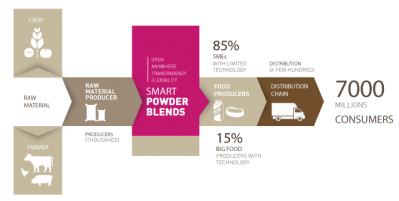Big interview
Bye-bye black box: Could ‘radical transparency’ transform the food industry?

He is frustrated by ‘black box’ blends of food ingredients, whereby raw material producers and then specialist blenders mix together different kinds of ingredients without indicating what they are or where they come from. A company could blend whey protein concentrate, milk protein concentrate and skimmed milk powder, for example, and then label the blend ‘milk proteins’ – or mix pectin of varying quality and origin and simply label it ‘pectin’.
Stamm Kristensen says that using this kind of blend is the norm for nearly everyone in the industry, and suppliers use the black box model to cherry-pick the cheapest ingredients and maximise profit margins.
“They are not interested in being transparent,” he said. “…As long as you have this black box there is no trust.”
Companies want blends – but not the black box
While major food manufacturers have the resources to go directly to raw material suppliers for ingredients, 99.1% of the European food industry is made up of small and medium-sized enterprises – and larger companies use blends too.
“Most of the big companies – including Nestlé – want blends. They just don’t want the black box…Food companies are good at producing the food and distributing the food; anything behind that they don’t want to deal with.”
Instead, he talks about a total transformation for the industry, in which food companies are – for the first time – informed very precisely about what goes into blends.
“They want more transparency,” he said. “The first ones that are not transparent are the raw material producers. They are already blenders. They blend fraction one and fraction two.
“This industry is infested with blends and this has grown into a market where the trust is not there.”
Paying for ‘real technology’
But Stamm Kristensen is not just talking about listing ingredients. The ‘radical transparency’ he advocates entails fully itemised invoicing, including the source and cost of raw materials, as well as fixed and variable costs, including labour costs.
Industry-wide transparency could mean that 80% of black box blends are open by 2020, he says, explaining that this proportion of blended ingredients is not technologically innovative.
“The 20% is patentable: It’s real technology,” he said. “We believe the food producers should not pay for a blend that does not add technological benefits.”
There are some areas in which the company does not add a lot in terms of fixed and variable cost, and he said that in some cases, if companies could save money by going directly to the raw material suppliers, he would advise them to do so.
Call for competition
Stamm Kristensen claims that such complete transparency in blends could create an entirely new industry category, doing away with the black box model altogether – but he acknowledges that a new category can only be consolidated when competitors get on board.
“If you are able to develop a new category, it’s much more important than the company itself,” he said.
And he insists that the company is actively trying to attract competitors to the idea.
“Many people are anchored in ‘we are competitors’, and we are trying to tell them that we are not.
“We put all our technology at their disposal – except our IP solutions, which need more time.”
Fully portable factories
The end goal is to bring prices down across the industry, he says, and with this in mind, the company also has developed fully portable, self-contained and quality controlled powder blending plants. Using a Google Maps-type tool, it can then calculate the optimal location to cut logistics costs for individual companies anywhere in the world.
“It is a completely disruptive concept,” he said. “The food industry is already on track to becoming local and I think this whole movement we have here is going to make it possible to go local much faster…Let’s start today, not with the price per kilo, but with the price of the finished product. What’s the person in Bangladesh able to pay?”
He added: “We have the possibility with this tool to change the whole industry – all the different applications; to make foods better, safer and cheaper.”






















